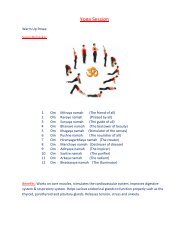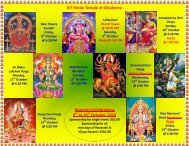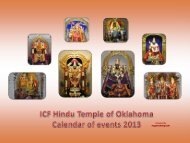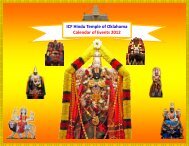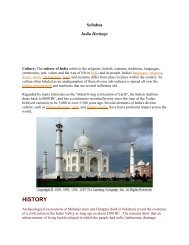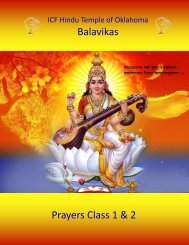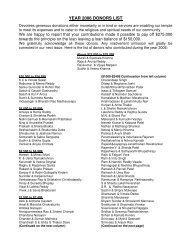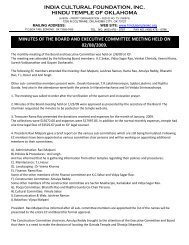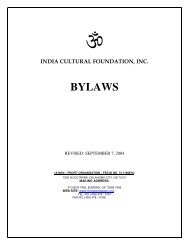Balavikas - Hindu Temple of Oklahoma City
Balavikas - Hindu Temple of Oklahoma City
Balavikas - Hindu Temple of Oklahoma City
Create successful ePaper yourself
Turn your PDF publications into a flip-book with our unique Google optimized e-Paper software.
ICF <strong>Hindu</strong> <strong>Temple</strong> <strong>of</strong> <strong>Oklahoma</strong><br />
<strong>Balavikas</strong><br />
<strong>Hindu</strong> Philosophy
The Scriptures <strong>of</strong> <strong>Hindu</strong>ism<br />
1. The Srutis<br />
Vedas<br />
(revealed by God directly)<br />
(Apaurusheyas)<br />
Rig Veda<br />
(Hymns in praise <strong>of</strong><br />
divine)<br />
Yajur Veda<br />
(Hymns used in religious<br />
rites)<br />
Sama Veda<br />
(Rig Veda set in music)<br />
Atharva Veda<br />
(guides man in<br />
material & daily living)<br />
Parts <strong>of</strong> Vedas<br />
Mantras<br />
(Hymns)<br />
Aranyakas<br />
(Forest books mystical)<br />
Upanishads<br />
(Essence <strong>of</strong> Vedas)<br />
Upanishads (108 in all)<br />
12 are most important<br />
1. Isa 2. Kena 3. Katha 4. Prasna 5. Mundaka 6. Mandukya 7. Aitareya 8. Taittiriya<br />
9. Chandogya 10. Brihadaranyaka 11. Kaushitaki 12. Svetasvatara<br />
Upavedas or Subsidiary Vedas<br />
Ayurveda<br />
(health & medicine)<br />
Dhanurveda<br />
(science <strong>of</strong> Archery)<br />
Gandharvaveda<br />
(music & dance)<br />
Arthashastra<br />
(state administration<br />
policy)<br />
Vedangas<br />
1. Siksha 2. Vyakarana 3. Nirukta 4. Chandas Shastra 5. Kalpashastra 6. Jyotisha
2. Smritis<br />
(which one remembered)<br />
Human Composition<br />
(list <strong>of</strong> codes & rules <strong>of</strong> everyday<br />
life)<br />
Day <strong>of</strong> Brahma is called Kalpa<br />
Satya or Krita Yuga Treta Yuga Dwapara Yuga Kali Yuga<br />
Smritis<br />
(18 in number)<br />
Manu Yajnavalkya Shankha Likhita Parashara<br />
3. Ramayana<br />
Ramayana Mahabharata Yogavasista Harivamsa
4. The Puranas<br />
18 Puranas<br />
(most popular)<br />
Bhagavata Vishnu Markandeya<br />
18 Upapuranas<br />
(For ordinary people short stories convey the truths <strong>of</strong><br />
Vedas & Dharmashastras)<br />
Ø1. God is everywhere - Narsihma Avatara<br />
Ø2. Power <strong>of</strong> purity - story <strong>of</strong> Savitri<br />
Ø3. Importance <strong>of</strong> prayer - story <strong>of</strong> Dhruva<br />
Ø4. Story <strong>of</strong> Devotion - Markandeya story<br />
Ø5. Looking after your elders - story <strong>of</strong> Shravana<br />
Ø6. Story <strong>of</strong> generosity - story <strong>of</strong> Sibi king<br />
Ø7. Story <strong>of</strong> Truth - story <strong>of</strong> king Harischandra<br />
Ø8. Poorest gift given <strong>of</strong> love is enough to please God - story<br />
<strong>of</strong> Sudama<br />
The Ten Incarnations<br />
1. Matsya 2. Kurma 3. Varaha 4. Narasimha 5. Vamana<br />
6. Parasurama 7. Rama 8. Krishna 9. Buddha 10. Kalki
5. Agamas<br />
(Disciplines & doctrines <strong>of</strong> worship<br />
<strong>of</strong> each deity<br />
1. Shaiva<br />
2. Vaishnava<br />
Shaiva sidhanta in south<br />
Pratyabhijna system in Kashmir<br />
Pancharatra (more popular it is believed<br />
to be revealed by great God<br />
Vaikhasana<br />
3. Shakta<br />
Glorifies Devi<br />
Agama<br />
1. Philosophy & spiritual<br />
knowledge behind worship<br />
<strong>of</strong> each deity.<br />
2. Yoga mental discipline<br />
required for worship.<br />
3. Rules for constructing<br />
temples.<br />
6. Darshanas<br />
(Visions – there are 6<br />
schools <strong>of</strong> philosophy)<br />
1. Nyaya by Gautama Rishi<br />
4. Yoga by Patanjali<br />
2. Vaiseshika by Kannada<br />
5. Mimansa by Jaimini<br />
3. Sankhya by Kapila Muni<br />
6. Vedanta by Badarayana (Vyasa)
Religion<br />
Religion is the remedy for a particular unrest felt by the human being when he or she has all the<br />
best that life has to <strong>of</strong>fer. Religion is the technique by which we set our minds and intellects<br />
trained to grasp and understand the larger theme <strong>of</strong> the universe and our own place in it.<br />
All the spiritual literature <strong>of</strong> the world says unhappy state <strong>of</strong> mind need not be<br />
ours. Each individual learns the art <strong>of</strong> approving life correctly everyone can be happy and be<br />
successful. We have in each one <strong>of</strong> us all the resources, abilities, energy and power for building<br />
up supremely happy and successful life, not only for ourselves but for others around us also.<br />
Everyone is born with a great potential within himself or herself and if we order our<br />
behavior so as to nurture and nourish that potential our life will be well spent and our success<br />
depends on the amount <strong>of</strong> transformation we can bring about in our character and<br />
behavior.The science <strong>of</strong> the spirit has a very practical use for us. The approach to life that helps<br />
us to discover new strength to face challenge <strong>of</strong> life and a new courage <strong>of</strong> conviction to live<br />
honestly serving others. That which provides us with such method and masterly living is true<br />
religion.<br />
Religion does not attempt to implore the conditions <strong>of</strong> the world. It does not grant us<br />
higher standards <strong>of</strong> living or freedom from all our needs. Instead it teaches us a method for<br />
creating in our selves the equipoise to stand up to life situations meeting efficiently the ever<br />
changing world <strong>of</strong> challenges. A true religion imparts to us “the art <strong>of</strong> living”.<br />
Science has conquered nature and human being as a result <strong>of</strong> knowledge accumulated<br />
has gained mastery over the outer world. Despite the mastery over outer world we still feel<br />
unhappy and unfulfilled. The great sages <strong>of</strong> the past taught that a particular kind <strong>of</strong> knowledge<br />
can transform our lives and bring to us a fullness <strong>of</strong> transformation and that no other endeavor<br />
yields “knowledge <strong>of</strong> our inner spiritual constitution”, a knowledge <strong>of</strong> our inner spiritual<br />
constitution that gives us mastery <strong>of</strong> our lives.<br />
The knowledge <strong>of</strong> which the sages spoke grew out <strong>of</strong> their analysis <strong>of</strong> human beings and<br />
their contact with outer world. They designed the instruments that contact the world and their<br />
experience life as the body, mind & intellect.<br />
Religion is a scientific reevaluation <strong>of</strong> life. Like a scientist goes to lab for research, the<br />
spiritual masters have retired to the cool and silent valleys <strong>of</strong> the Himalayas to do their research<br />
on human personality.
Material scientist uses outer world for their investigation. Spiritual master’s user inner<br />
world for their study. The philosophy <strong>of</strong> <strong>Hindu</strong>s has emphasized the importance <strong>of</strong> experience<br />
more than the philosophy <strong>of</strong> the west.<br />
In <strong>Hindu</strong> philosophy Vedanta has the unique distinction <strong>of</strong> having based itself on the entire<br />
range <strong>of</strong> human experience namely “waking, dream, and deep sleep”<br />
Religion is the technique <strong>of</strong> perfect living <strong>of</strong> gaining better mastery <strong>of</strong> our selves e.g.<br />
Bhagavad Gita: The transformation <strong>of</strong> Arjuna whose dialogue to Lord Krishna is an example <strong>of</strong><br />
how spiritual wisdom can transform one’s life.
What Is <strong>Hindu</strong>ism<br />
<strong>Hindu</strong>ism is the oldest religion in the world and about four in five Indians in India is a<br />
<strong>Hindu</strong>. Besides India, <strong>Hindu</strong>ism is also followed in Nepal, Bali and by millions <strong>of</strong> Indians that live<br />
overseas. Many cultures in Southeast Asia are influenced by <strong>Hindu</strong>ism.<br />
The history <strong>of</strong> <strong>Hindu</strong>s, as we know today, goes back 5000 years, but <strong>Hindu</strong>s believe that<br />
their religion is without beginning or end and is a continuous process even preceding the<br />
existence <strong>of</strong> our earth and many worlds beyond. The word "<strong>Hindu</strong>" is derived from the name<br />
given to people settled on the banks <strong>of</strong> river Sindu. It was corrupted by foreign visitors to the<br />
word "<strong>Hindu</strong>" and the faith was given the name "<strong>Hindu</strong>ism" in the English language. Scholars<br />
however call it Brahmanical faith, meaning to attain Brahman or universal soul which is the aim<br />
<strong>of</strong> all <strong>Hindu</strong> thought. Philosophical thinkers <strong>of</strong> recent times do not like to describe it as mere<br />
religion, as it does not bring out adequately its great qualities and the universality <strong>of</strong> its outlook<br />
and free thinking. An atheist is not precluded from being a <strong>Hindu</strong> and no hell or doomsday is<br />
believed. It is therefore called "Sanathana Dharma" or "eternal religion." Others call it a<br />
fellowship <strong>of</strong> religions from its liberal absorption <strong>of</strong> all faiths <strong>of</strong> others.<br />
<strong>Hindu</strong>ism is very simple and yet very complex; it permeates totally the life <strong>of</strong> every<br />
<strong>Hindu</strong> from the moment <strong>of</strong> his or her birth, whether they are a believer or non-believer, a<br />
scholar or illiterate. For this reason <strong>Hindu</strong>ism is called a way <strong>of</strong> life.<br />
Before we go any further, we should realize that <strong>Hindu</strong>ism is a rare faith with few "dos’’<br />
and "don’ts’ postulated, but <strong>of</strong>fers many spiritual paths available to different types <strong>of</strong> people. It<br />
accepts the reality that there is varying intellectual and spiritual levels in each one <strong>of</strong> us and all<br />
do not therefore take the same path, although the goal may be same. <strong>Hindu</strong>ism is tailored to<br />
each individual with different aptitude, depending on if you are a philosopher or a poet, a<br />
mystic or or a person <strong>of</strong> action, an intellectual or a simple person <strong>of</strong> faith. This is a unique<br />
feature <strong>of</strong> <strong>Hindu</strong>ism; it permits the greatest freedom <strong>of</strong> worship and insists that each person<br />
must be guided by his or her own individual spiritual experience. It does not accept dictatorship<br />
in religious guidance.<br />
Another quality unique to <strong>Hindu</strong>ism is its tolerance <strong>of</strong> other religious faiths and beliefs.<br />
In the Bhagavad Gita Lord Krishna, worshiped as an incarnation <strong>of</strong> Lord Vishnu, himself says,<br />
‘’Whosoever follows my faith and worships me under whatsoever denomination in whatsoever<br />
form with steadfastness, his faith shall I indeed reinforce’’. Most other religions say, "Your<br />
religion is wrong and to follow it is a sin. Get converted to my religion and heaven will be<br />
yours." The lord worshiped by <strong>Hindu</strong>s implies in effect, ‘’Come to me as a <strong>Hindu</strong>, Christian,<br />
Muslim or Sikh, I shall make you a better <strong>Hindu</strong>, Christian, Muslim, or Sikh." Conversion to<br />
<strong>Hindu</strong>ism has never been a major issue and has never been done through force or wars, nor as<br />
a result <strong>of</strong> bigotry or by temptations <strong>of</strong>fered to the economically week.<br />
<strong>Hindu</strong>ism, again unique amongst other religions, allows a <strong>Hindu</strong> to worship in a church,<br />
mosque or a gurudwara as freely as in a temple. <strong>Hindu</strong>ism allows social change and scientific
progress. Yet is highly philosophical and sublime, aiming at ethical perfection. However it is<br />
most unfortunate that today even educated <strong>Hindu</strong>s are <strong>of</strong>ten unaware as to what the religion<br />
teaches or stands for or what its fundamental beliefs are.<br />
The freedom <strong>of</strong>fered by this religion, which does not ask an individual to visit a temple<br />
once a week, has been misused and has led to widespread ignorance <strong>of</strong> what the religion<br />
stands for. This can be tracked to the urbanization <strong>of</strong> villages and breaking down <strong>of</strong> the family<br />
unit. While superstitions, which have nothing to do with the religion, are picked up, the<br />
meaning <strong>of</strong> the symbolism and mantras is lost. Religious rituals and rites are performed by<br />
family members on rare occasions, so children and adults do not have an understanding <strong>of</strong><br />
their significance. In our balavikas class we will try to understand the significance <strong>of</strong> the<br />
philosophy behind some <strong>of</strong> the symbols and rituals.<br />
The rishis were seers or sages to whom the Vedas were revealed by Divine intervention<br />
and whose hearts and minds they were heard. T he Vedas are Apaurushas [<strong>of</strong> devine orgin] and<br />
are unchangeable and eternal. They teach the highest truths ever known to man, and are valid<br />
for all times and ages. <strong>Hindu</strong>s believe that creation is anadi [that which s no beginning] and that<br />
it is eternal. At the nod <strong>of</strong> each KALPA [a unit <strong>of</strong> time equal to a day <strong>of</strong> Brahma, the creator,<br />
amounting to 4,320 million years], it exists in a suttle form in God, from whence each time is<br />
recreated a new universe. At the end <strong>of</strong> the last age, there was a Pralaya or great Deluge which<br />
destroyed the universe. Brahma the creator, is believed to have meditated at dawn <strong>of</strong> this age,<br />
called Swetavaraha Kalpa, when the great God appeared in the form <strong>of</strong> sound <strong>of</strong> OM also<br />
known as pranava.OM ,as the symbol <strong>of</strong> the absolute, is therefore the most sacred symbol <strong>of</strong><br />
<strong>Hindu</strong>ism.<br />
Brahma then prayed to him for knowledge to create a Universe from the vibrations <strong>of</strong><br />
the sound OM also spelt AUM, the Lord Concaved Rig Veda, Yagur Veda, Sama Veda and<br />
Atharva Veda. The Great god then taught these four Vedas to Brahma who created our present<br />
Universe with this supreme knowledge received by him. In other words Vedas existed before<br />
the creation <strong>of</strong> the universe. Sage Veda Vyasa codified the four Vedas. His disciples, Palia,<br />
Vaisampanya, Jaimini, and Sumanta taught them to their disciples and the later, in turn to their<br />
pupils. This is how the Vedas have come to us through thousands <strong>of</strong> years. They are called<br />
amnaya, or that which has come to us by tradition.<br />
THE RIG VEDA consists <strong>of</strong> mostly hymns in praise <strong>of</strong> the devine<br />
THE YAGUR VEDA consists <strong>of</strong> mainly hymns used in religious<br />
rituals and rites<br />
THE SAMA VEDA consists <strong>of</strong> verses from rig Veda set to music<br />
THE ATHARVA VEDA guides man in his material daily living
The Scriptures Of The <strong>Hindu</strong>ism<br />
<strong>Hindu</strong>ism is not based on any single book or the words <strong>of</strong> any teacher or prophet. It is<br />
based on the Eternal Truth. However, there are literally thousands <strong>of</strong> books and scriptures to<br />
guide both the beginner and the scholar.<br />
THE SRUTI - The first set <strong>of</strong> books which are the primary authority, or the very soul <strong>of</strong> <strong>Hindu</strong>ism,<br />
are known as ‘SRUTI’ meaning that which has been heard or revealed. These Srutis are known<br />
as Vedas. The word "Veda" is derived from the word "vid" to know. The Vedas are holy or<br />
spiritual knowledge <strong>of</strong> the Eternal Truth. The word "rishi" is derived from the word "Dris" to<br />
see.<br />
The Vedas have several parts -<br />
Vedas / Mantras [or hymns]<br />
Brahmana (explanations for using mantras in rituals)<br />
Aranyakas [or forest books] mysticalinterpratations <strong>of</strong> mantras or rituals]<br />
Upanishads [most important part <strong>of</strong> the Vedas]<br />
The summery or essence <strong>of</strong> Vedas and the philosophy Upa; near [the master] Ni; with<br />
concentration on what is being taught, Shad; Sit<br />
The knowledge <strong>of</strong> Upanishads removes Avidya or ignorance the one greatest failings<br />
<strong>of</strong> mankind.<br />
Upanishads \ 108 in number\ 12 are the most important--- ISA , KENA , KATHA , PRASNA ,<br />
MUNDAKA , MANDUKYA , AITREYA , TAITTIRIYA , CHANDOGYA , BRIHADARANYAKA ,<br />
KAUSHITAKI AND SVETASVATARA .<br />
The Upanishads reveal some <strong>of</strong> the greatest truths ever known to mankind .The next<br />
set <strong>of</strong> books are the UPAVEDAS \ AYURVEDA Science <strong>of</strong> extending life by using medicinal<br />
herbs roots and fruits for treating illness and diseases and highly developed school <strong>of</strong> surgery.<br />
Charaka, the great <strong>Hindu</strong> physician was possibly the first to speak <strong>of</strong> code <strong>of</strong> ethics for<br />
physician to treat patients without the thought <strong>of</strong> gain or reward, and to keep confidentiality <strong>of</strong><br />
patient illness.<br />
Sushruta, was a great ancient surgeon developed 120 surgical instruments .Plastic<br />
surgery was well developed and deformities <strong>of</strong> nose ears and lips were set right. The skill <strong>of</strong><br />
plastic surgery was taken to the west by east India Company.<br />
DHANURVEDA science <strong>of</strong> archery and and use <strong>of</strong> weapons. Even weapons like missiles<br />
are covered in this .There were rules <strong>of</strong> warfare and weapons were used for destruction <strong>of</strong> evil<br />
and protection <strong>of</strong> physically weak, <strong>of</strong> sages <strong>of</strong> meditation. And <strong>of</strong> holly men and women and<br />
children. Opposing armies laid down their weapons at sunset and dined together.
GANDHARVA VEDA science <strong>of</strong> music and dance. Sage Bharata has written the Natya<br />
Shastra, he has been taught by Sage Tandu who has witnessed the cosmic dance <strong>of</strong> Lord Shiva.<br />
The musical Sama Veda, placed emphasis <strong>of</strong> on musical notation and sound .these were taught<br />
by rote memory sound and acoustics .The musical octave was accurately divided into 22<br />
quarter tones. The musical instruments consisted <strong>of</strong> percussion [drums] wind instruments<br />
[flute] string instruments [vina] Music was considered as a source to reach god head.<br />
ARTHASHSTRA this is a treatise on polity, state administration .and conduct <strong>of</strong><br />
commerce. The vedangas have science <strong>of</strong> phonetics and accent and pronunciation. Vyakarana<br />
.science <strong>of</strong> grammar, Nirukta, science <strong>of</strong> etymology <strong>of</strong> words in Vedic mantras. Chandra shastra,<br />
teaches prosody, the art <strong>of</strong> versification, teaches the use <strong>of</strong> meters in prose and poetry.<br />
Kalpashastra deals with science <strong>of</strong> rituals and ceremonials in religious rites. Jyotishya science <strong>of</strong><br />
astronomy and astrology. Knowledge <strong>of</strong> astrology was used to set auspicious timings for events<br />
<strong>of</strong> peace and war. After 6 th century it was used for predicting future <strong>of</strong> individual.<br />
The knowledge <strong>of</strong> mathematics was conveyed to Arab and the Greek worlds. The<br />
concept <strong>of</strong> zero [sunya], abstract concept <strong>of</strong> numbers, algebra, the decimal numbers, all owe<br />
their origin to ancient <strong>Hindu</strong>s. The ISAVASYA Upanishad has the revolutionary mathematical<br />
truth that infinity divided by any number continues to be infinity.<br />
Astronomy was an important branch <strong>of</strong> the science <strong>of</strong> Jyotisha and the ancient<br />
<strong>Hindu</strong>s sent their advanced theories <strong>of</strong> mathematics to Europe through Greeks. Aryabhata the<br />
ancient Indian astronomer mentioned that it is the earth which, on its axis rotated around the<br />
sun and not the sun. Knowledge <strong>of</strong> equinoxes the movement <strong>of</strong> moon and sun, the predictions<br />
<strong>of</strong> eclipses were all accurately predicted.[the open air observatory at Jaipur] the above books<br />
are part <strong>of</strong> the srutis or Vedas and are the first set <strong>of</strong> scriptures.
The Smritis<br />
Smritis mean that which is remembered. Unlike srutis which are divine in origin smritis<br />
are written by learned masters. These guide individuals in their daily conduct and list codes and<br />
rules governing the actions <strong>of</strong> individuals. They are known as Dharma Shastras or laws<br />
governing righteous conduct. The day <strong>of</strong> Brahma the creator is known as Kalpa is divided into<br />
four ages or Yugas.<br />
Satya or Krita Yuga<br />
Treta Yuga<br />
Dwapara yuga<br />
Kali Yuga [the present age] which is age <strong>of</strong> decling <strong>of</strong> virtue<br />
There are total <strong>of</strong> 18 smritis. There were many law givers like Manu , Yagnavalkya , Shankha ,<br />
Likhita and Parasa.<br />
Manu was the earliest <strong>of</strong> them .Today the <strong>Hindu</strong> law is based on Yagnavalkya smriti.<br />
<strong>Hindu</strong>ism is unique in that the rules <strong>of</strong> society change with every age ,and therefore the laws ,or<br />
Dharma Shastras , must change from time to time. <strong>Hindu</strong>ism is a practical religion as it accepts<br />
the laws governing the conduct <strong>of</strong> man and society are manmade and and should be flexible<br />
and dynamic and should be subject to change. these smritis were used by Kings and Priests .<br />
The Epics<br />
As ordinary people do not have the intellect or education to read and understand<br />
these books, there are a third set <strong>of</strong> books, the Itihasas or Epics that serve the purpose. The<br />
philosophy <strong>of</strong> Upanishads is presented in the form <strong>of</strong> Parables and stories in these Epics so even<br />
a common man can understand.<br />
The great Epics <strong>of</strong> <strong>Hindu</strong>ism are THE RAMAYANA THE MAHABHARATA THE<br />
YOGAVASISTHA THE HARIVAMSA .They are also called SUHRIT SAMHITAS or friendly<br />
compositions , as they teach the greatest truths in a simple friendly way. They are easily<br />
understood by one and all. Of these four Ramayana and Mahabharata are well known to even<br />
most illiterate <strong>of</strong> all the <strong>Hindu</strong>s. They are told as stories enacted as plays and sung as songs.<br />
They teach the ideals <strong>of</strong> <strong>Hindu</strong>ism in a simple understandable way. Every peasant and villager in<br />
India is knowledgeable about the basic <strong>Hindu</strong> values because <strong>of</strong> these Epics.<br />
Ramayana is the most popular Epic It is also known as ADIKAVYA OR THE FIRST<br />
POETIC COMPOSITION OF THE WORLD .It was written by the great sage Valmiki. This is the<br />
story <strong>of</strong> lord Rama an incarnation <strong>of</strong> Lord Vishnu born on earth to show path <strong>of</strong> righteousness.
Rama Rajya, the reign <strong>of</strong> Rama, was one <strong>of</strong> idealism and perfection where no tear was<br />
shed or sorrow was experienced. People were good to each other and there was peace and joy.<br />
Ayodhya was a land <strong>of</strong> tolerance and understanding, even the king‘s actions were subject to the<br />
will <strong>of</strong> people.<br />
In this Epic the qualities <strong>of</strong> an ideal queen Kausalya and Sumitra who put king<br />
Dasharathas word above the love <strong>of</strong> their sons King Dasharatha who kept his promise to queen<br />
Kaikeyi and Lord Rama who obeyed his father’s orders without any questions . This shows the<br />
importance <strong>of</strong> the value <strong>of</strong> a spoken word and keeping up a promise which were very important<br />
for a king. Also the sacrifices <strong>of</strong> a <strong>Hindu</strong> women are depicted in several such instances.<br />
Bharata was a very good example <strong>of</strong> a principled man who on return from a visit to his<br />
uncle, finds his brother banished to forest for 14years and his father dying <strong>of</strong> grief .He does not<br />
take over as a king as he knew it was not the right thing to do waits till his brother comes back<br />
from forest .He places his brothers PADUKAS on the throne. Even an ordinary man realizes the<br />
qualities <strong>of</strong> an ideal man in Rama and that <strong>of</strong> an ideal woman and wife in Sita Qualities <strong>of</strong> ideal<br />
brother are well depicted in Bharata, Lakshmana, and Shatrugna.<br />
The ideal qualities <strong>of</strong> loyalty. Devotion and love are depicted in the character <strong>of</strong><br />
Hanuman, the monkey who helped Rama cross over the ocean to Lanka and defeat Ravana and<br />
bring back Sita. Hanuman also brings the herb sangivani to save Lakshmana as he knew that his<br />
beloved Rama could not live without Lakshmana.<br />
The qualities <strong>of</strong> good and evil are always depicted again and again. The destruction<br />
<strong>of</strong> evil by good either by oneself or by Devine intervention [like in Ramayana] is a constant<br />
theme in <strong>Hindu</strong>ism.<br />
Even the demons were all not bad and wicked and are shown as having good<br />
qualities also. Ravana a very learned man who abducted Sita for her beauty and good virtues<br />
did not force her but waited for her consent to marry her. Even Hanuman admires Ravana’s<br />
courage and strength. Ravana’s brother the demon Kumbhakarna, disapproved strongly <strong>of</strong><br />
abduction <strong>of</strong> Sita.<br />
The second epic is called Mahabharata was compiled by VEDA VYASA is a story <strong>of</strong><br />
two royal families the Pandavas and the Kauravas who were first cousins. Pandavas were five<br />
and Kauravas were one hundred. This epic the central character is LORD KRISHNA an<br />
incarnation <strong>of</strong> LORD VISHNU himself. When confronted with war with his cousins uncles grand<br />
uncle and teachers Arjuna one <strong>of</strong> the five brothers feels dejected does not want to fight the war<br />
and LORD KRISHNA teaches ARJUNA the path <strong>of</strong> DHARMA [righteousness] LORD KRISHNA was<br />
Arjuna’s charioteer .The great <strong>Hindu</strong> scripture BHAGAVAD GITA OR THE SONG OF THE LORD,<br />
was narrated by the LORD to Arjuna at KURUKSHETRA war.
In this scripture, Lord Krishna places the importance <strong>of</strong> NISKAMAKA KARMA or action<br />
without desire or passion and without any worry about the frits or results <strong>of</strong> one’s actions. Here<br />
the duties and the right conduct <strong>of</strong> an ideal man are shown setting the rights and wrongs <strong>of</strong><br />
society. The Upanishads are compared to a cow the BHAGAVAD GITA to milk, Krishna to a<br />
cowherd and Arjuna to a calf. In other words the essence <strong>of</strong> the Upanishads is milked by<br />
Krishna and the milk. The Bhagavadgita fed to Arjuna. In Shantiparva <strong>of</strong> the Mahabharata<br />
grand-uncle Bhishma utters to Yudihstra the oldest <strong>of</strong> the pandava brothers the words <strong>of</strong><br />
wisdom, on Dharma or righteous conduct, and the duty on statecraft and the responsibilities <strong>of</strong><br />
a ruler.
The Puranas<br />
After srutis, smritis, and itihasas we have the fourth set <strong>of</strong> books the puranas. There<br />
are 18 puranas <strong>of</strong> which THE BHAGAVATAS, VISHNU, AND MARKANDEYA puranas are the most<br />
popular. There is 18 subsidiary or UPA PURANAS .These are not for the scholars or intellectuals<br />
but for the common man a farmer a villager and a child. They are told as imaginary stories and<br />
are filled with fundamental truths <strong>of</strong> religion and morality <strong>of</strong> what is right and wrong in a<br />
society.<br />
These Puranas have been told by word <strong>of</strong> mouth by grandparents to their grand<br />
children and by the village priest and by the wandering minstrel. The walls <strong>of</strong> temple are<br />
covered with the carving <strong>of</strong> Puranic stories, a visual method <strong>of</strong> educating the ordinary people.<br />
For example to teach the people that god is everywhere and always comes to help<br />
his devotee, the story <strong>of</strong> Prahalada is told.Prahalada’s father the demon king Hiranya kasipu<br />
tried to convince his son that there is no other greater Divine than himself and advises his son<br />
to pray to him but Prahalad was an ardent devotee <strong>of</strong> lord Vishnu continues to pray and was<br />
saved by the lord on several instances .his own father orders him to be killed but each time he<br />
fails.<br />
Lord Vishnu appears as Narasimha [half man and half lion] and kills Hiranyakasipu. The<br />
latter had a Boone that he will not be killed by a man or a beast neither at night or day and no<br />
weapon. But the child Prahalada insisted that God is everywhere and in everyone. When<br />
Hiranyakasipu challenges and says ‘’is he in this pillar’’ and hits the pillar and the Lord comes<br />
out as Narasimha and kills him [ego is killed] this story teaches that god comes to us in different<br />
ways and helps us when we have full faith in him. The puranas taught the power <strong>of</strong> a chaste<br />
and good woman in the story <strong>of</strong> savitri. She was the daughter <strong>of</strong> king <strong>of</strong> Madra, Savitri chose<br />
Satyayan who was predicted to die within a year <strong>of</strong> their wedding. Satyavan was the son <strong>of</strong> a<br />
deposed and blind king and lived in a forest. On the day <strong>of</strong> his predicted death Satyavan goes to<br />
fetch some wood and Satyavati follows him all the time thinking as to how to save him.<br />
By her power <strong>of</strong> her purity Savitri follows Lord Yama [God <strong>of</strong> death] when he takes the<br />
prana or breath <strong>of</strong> life <strong>of</strong> Satyavan. Yama pleased by her devotion and wisdom grants her four<br />
boons provided she does not ask for Satyavan’s life. Savitri asks as her fourth boon that she<br />
wishes to have hundred sons and Yama grants her wish. She then asks Yama as a chaste<br />
woman how is to have children without a husband. Yama had no choice but to return Satyavan<br />
back to her alive. The story <strong>of</strong> Dhruva, a young prince who by his constant meditation and faith<br />
on lord Vishnu one the eternal blessings <strong>of</strong> the lord. Thus proving that with sincere prayer and<br />
strong faith one can move God. To this day Dhruva is well known as a pole star.<br />
The story <strong>of</strong> Markandeya how a boy <strong>of</strong> sixteen conquered his fate by his devotion to Shiva.<br />
Markendeya did not allow his predestined death to take him away by his bhakti or devotion and<br />
was given the gift <strong>of</strong> immortality. Even today when we bless a child after he sneezes we wish<br />
him long life like Markandeya. These stories are embedded in every Indian household to this
day. To teach children the importance <strong>of</strong> looking after their elders ,we have a story on Shravana<br />
a young boy ,who denied himself <strong>of</strong> all joys <strong>of</strong> childhood while caring for his old and blind<br />
parents. When they wished to go on pilgrimage to holy cities, he placed them in bamboo<br />
baskets tied a pole which he carried on his shoulders and cheerfully took the journey even<br />
though it was a discomfort for him. The family ties are very strong in India even today a peasant<br />
works in large cities and supports family in a village.<br />
Another interesting story is that <strong>of</strong> king Usinara <strong>of</strong> sibi clan who was very just and wise<br />
and whose generosity knew no bounds. Once a dove rushed to him to for help to escape from a<br />
hawk the king gave him protection. The hawk protested at being deprived <strong>of</strong> its food. Usinara<br />
then <strong>of</strong>fers to give flesh from his thigh but however much flesh he cuts from his body the dove<br />
weighs more. The king then <strong>of</strong>fers his entire self to balance the scale. Indra the king <strong>of</strong> devas<br />
[celestial beings or lesser gods] and Agni took the form <strong>of</strong> the dove and hawk to test king<br />
Usinara and his generosity.<br />
To teach the importance <strong>of</strong> adhering to truth the story <strong>of</strong> Harischandra who was a king<br />
is told. The king gave away his kingdom to pay his loan to Viswamitra and gives away his wife<br />
and son as slaves .Finally he sells himself as a slave to the keeper <strong>of</strong> cremation grounds to<br />
payback the rest <strong>of</strong> the loan .However Harischandra’s sorrow had no bounds when his wife<br />
brought his sons dead body to the cremation ground. When Harischandra and his wife taramati,<br />
decided to end their life by falling in the funeral pyre, Indra and Yama appear before them and<br />
save all three <strong>of</strong> them. And Harischandra’s adherence to truth is a lesson to even to gods. The<br />
importance <strong>of</strong> truth and the inviolability <strong>of</strong> the spoken word are therefore taught in many<br />
puranas. To prove the poorest <strong>of</strong> the gifts when given with love is enough to please god is told<br />
in the story <strong>of</strong> Sudama who went to the same hermitage school <strong>of</strong> sage sandeepa with lord<br />
Krishna. Sudama ‘s wife asks him to seek help from lord Krishna as they could not feed their<br />
children due to poverty he had no gift to take except a handful <strong>of</strong> beaten rice. Lord Krishna<br />
readily accepts the gift and when Sudama returns home he finds his hut to be a mansion and<br />
his family prosperous and happy.
Puranas<br />
It is in the puranas we read about the ten avatars or incarnations <strong>of</strong> lord Vishnu. These<br />
incarnations describe the help given by god during the various stages <strong>of</strong> mans evolution by His<br />
appearance on earth in different forms.<br />
These avatars teach mankind that God has re-established Dharma or righteous justice<br />
and destroyed injustice from time to time by appearing on earth in various incarnations.<br />
Matsya [fish] kurma [tortoise] varaha [boar] Narasimha [half lion half man] Vamana<br />
[the dwarf] Parusurama [the angryman] Rama [the perfect man] Krishna [the divine statesman]<br />
and Budha [the compassionate man]<br />
The first avatar Matsya the fish, was taken by V Vishnu at the end <strong>of</strong> last Kalpa or age,<br />
where there was deluge that destroyed the world that existed then. Choosing a sage, Rishi<br />
Satyavrata, Lord Vishnu commanded him to gather together the seven sages. Samples <strong>of</strong> all<br />
animals’ birds, plants and seeds. And wait in the boat. The gigantic golden fish then dragged the<br />
boat through the turbulent oceans all through the long, long night <strong>of</strong> Brahma till the deluge<br />
ended and Brahma created the present world. Another version has it that a demon has once<br />
stolen the four Vedas and hid them under the sea. Vishnu took the form <strong>of</strong> a giant fish and<br />
retrieved them.<br />
In the kurma avatara Vishnu took the form <strong>of</strong> a tortoise to help the Devas [lesser<br />
gods or heavenly beings] to obtain the nectar <strong>of</strong> immortality with the Asuras [demons] were<br />
also after. The Devas and asuras churned the ocean to get this nectar, using the giant snake<br />
Vasuki .as their churning rope and mount Mandara as the churning rod. To prevent the<br />
mountain from sinking into the ocean; Lord Vishnu took the form <strong>of</strong> giant tortoise and<br />
supported the mountain under water until the nectar <strong>of</strong> immortality emerged which Vishnu<br />
gave it to devas alone.<br />
At the end <strong>of</strong> the deluge in the last kalpa or age Bhoomi Devi [mother earth] sank into<br />
the bottom <strong>of</strong> the ocean .Vishnu in the form <strong>of</strong> varaha, dived into the bottom <strong>of</strong> the ocean and<br />
carried the goddess out <strong>of</strong> the waters supported by his massive snout.<br />
In order to destroy Bali, the king <strong>of</strong> demons, Vishnu took the avatar <strong>of</strong> midget Amana.<br />
He appeared during a huge Yajna or sacrifice being conducted by the king when the later was<br />
arrogantly distributing gifts to all who asked for it to show his wealth and power. Vamana just<br />
asked for three feet <strong>of</strong> land .measured by his own small feet. With his first foot he covered the<br />
earth, with the second he covered the heavens. When there was no place for the next foot <strong>of</strong><br />
land. Bali <strong>of</strong>fered his head to show that he kept his word. Lord Vishnu sent him to nether lands.
When the kings <strong>of</strong> earth became autocratic and started to harm ordinary people and<br />
sages in the forest lord Vishnu took the form <strong>of</strong> Parasurama and destroyed all the kshatriyas<br />
[princes] who were harassing the people.<br />
When priesthood became arrogant and priests used rituals to exploit the people,<br />
Vishnu took the Avatar <strong>of</strong> Budha to purify <strong>Hindu</strong> practices <strong>of</strong> excessive ritualism. He taught that<br />
all sorrow stemmed from attachments and desires and advocated a middle path consisting <strong>of</strong><br />
eight-fold virtues <strong>of</strong> right views, right resolve, right speech, right conduct, right livelihood, right<br />
effort, right mindfulness, and right meditation.<br />
<strong>Hindu</strong>s believe that at the end <strong>of</strong> this age, or kali Yuga, there will be a holocaust <strong>of</strong> fire<br />
when the last Avatar, that <strong>of</strong> Kalki, will ride forth to save mankind and reestablish Dharma, or<br />
righteousness.<br />
To summarize, we have covered four sets <strong>of</strong> books or scriptures so far. The first, srutis<br />
or Vedas are very soul <strong>of</strong> <strong>Hindu</strong>ism and are <strong>of</strong> divine origin. They are eternal and without<br />
beginning or end. The smiritis or dharma shastras are like body, subject to decay and can be<br />
changed from time to time, from age to age.<br />
The truths <strong>of</strong> the srutis and smritis are conveyed to the ordinary people through the<br />
great epics, which appeal to their hearts, and through puranas, which appeal to their<br />
imagination.<br />
The Agamas<br />
The fifth set <strong>of</strong> scriptures are the Agamas. They give the theological disciplines <strong>of</strong> worship <strong>of</strong><br />
different Deities. These have come from the three main Sects <strong>of</strong> <strong>Hindu</strong>s the Shaiva,<br />
Vaishnava and Shakta. The Shiva Agama has different philosophy in south and in Kashmir. In<br />
this agama the Supreme God is worshiped under different names <strong>of</strong> Lord Shiva.<br />
Similarly, there are two schools in Vaishnava Agama, the pancharatra and the<br />
Vaikhanasa, both glorify lord Vishnu. Of these the former is more popular as it is believed by<br />
the great God himself in the form <strong>of</strong> Vishnu. The Shakta Agama glorifies Devi, the consort <strong>of</strong><br />
Shiva, as the world Mother who, as Shakti, the energy giving power behind all creation,<br />
Creativity and destruction. Tantric worship uses many occult magical practices and is not<br />
accepted by main stream <strong>Hindu</strong>ism.<br />
This set <strong>of</strong> scriptures, the Agamas, guide the faithful to worship their Supreme<br />
Lord with devotion. Each Agama consists <strong>of</strong> philosophy and spiritual knowledge <strong>of</strong> behind the<br />
worship <strong>of</strong> the deity. As the first part and the yoga and the mental discipline required for each<br />
school in the second part.<br />
An important part <strong>of</strong> the third section <strong>of</strong> the agamas covers the rules for<br />
constructing <strong>of</strong> temples. That is why, whatever the outward architecture <strong>of</strong> any temple the plan<br />
<strong>of</strong> the temple is same all over the country. Some temples have Mandapas or halls. As the<br />
worship is not congregational but individual the Sanctum santorum is small and narrow.
The third section is equally important as rules <strong>of</strong> sculpting or carving figures <strong>of</strong><br />
the deities. Details such as how Lord Rama holds his bow, the length <strong>of</strong> his arms, and the<br />
graceful stance <strong>of</strong> Sita are all written down and the same in whatever part <strong>of</strong> the country the<br />
temple is built. The only difference is the facial features <strong>of</strong> the images which are usually<br />
patterned on racial characteristics <strong>of</strong> the local population.<br />
The fourth part <strong>of</strong> the Agamas consists <strong>of</strong> rules pertaining to the religious<br />
rites and rituals at home and in the community and the observance <strong>of</strong> religious festivals. These<br />
are slightly changed according to the local cultural differences. There are a lot <strong>of</strong> poetic<br />
compositions and devotional songs that have sprung under the name <strong>of</strong> these theological<br />
scriptures in all languages in the country.<br />
The Darshanas<br />
The sixth or last set <strong>of</strong> scriptures are the six Darshanas [meaning visions]<br />
which are schools <strong>of</strong> philosophy. These are for the intellectuals and scholars who have six main<br />
schools <strong>of</strong> philosophic thought to guide them.<br />
They are:<br />
NYAYA founded by Gautama Rishi<br />
Vaiseshika by Kannada<br />
Sankhya by Kapila muni<br />
Yoga by Patanjali<br />
Mimamsa by Jaimini<br />
Vedanta by Badarayana [Vyasa]<br />
The nyaya philosophy is guided by pure logic and reasoning. Although this<br />
philosophy is not very popular today it emphasis on logic and Tarka or debate. The vaiseshika<br />
philosophy talks <strong>of</strong> universe as consisting <strong>of</strong> countless atoms and each eithits own visesha or<br />
particular quality. The Sankhya philosophy is also based on logic and inference but its main<br />
belief system is that universe consists <strong>of</strong> two elements. Purusha and prakriti. [Sprit and<br />
matter]It is the oldest school and it is mentioned in Mahabharata.<br />
The yoga school accepts Sankhya philosophy but uses mind control as means <strong>of</strong><br />
attaining God head. Mimamsa places great emphasis on Vedic Rituals and sacrifices.Yagna as<br />
a sacrifice involves chanting Vedic Mantras and pouring Ghee [melted butter] and grain in the<br />
sacred fire.<br />
Vedanta means end <strong>of</strong> Vedas, based on the doctrine <strong>of</strong> Upanishads.<br />
Vedanta teaches that the supreme God can be reached only by ones individual spiritual<br />
experience.<br />
Each Veda has a karma kanda dealing with rituals, Upasana kanda dealing with<br />
worship, and Jnana kanda dealing with spiritual knowledge. Jnana kanda or path <strong>of</strong> knowledge<br />
is all important and others are steps to the final goal.
Vedanta insists on strict adherence to Truth and to tireless investigation. The<br />
Manduka Upanishad says “the path to the divine is through truth”. Untruth can never win .All<br />
thinking in India is has been affected by Vedanta which we may not be aware <strong>of</strong>. It is the root <strong>of</strong><br />
our belief s and culture. The three great commentators’ on Vedanta sutra were Adishankara,<br />
Ramanuja and Madhavacharya. Vedantic philosophy was influenced by western thinkers and<br />
philosophers like Nietzehe Spinoza.
The Trinity<br />
God is one who is called Ishwara or Brahman who has three main functions <strong>of</strong><br />
creation, preservation, and destruction. Brahma, Vishnu and Shiva according to their functions<br />
a high degree <strong>of</strong> symbolism has been involved in <strong>Hindu</strong>ism to explain the attributes and<br />
qualities <strong>of</strong> God Head to the masses.<br />
Same God is pictured with different features and expressions depending on the role<br />
they play. Ex, Lord Vishnu may be shown as a peaceful form in one temple and destroying evil<br />
in another. The weapons he holds may be different in each form. Brahma is shown with four<br />
heads facing all four directions symbolizing that he created the entire universe and is<br />
enlightened. The fact that he meditates and creates the universe in each Kalpa (or age) is<br />
symbolized by him holding the Vedas in one hand (which guide him), the vessel or Kamandalu<br />
he holds symbolizes the ritual he does before creation or prayer. He sits on a lotus which<br />
symbolizes purity .as the lotus grows in muddy waters but is untouched by the dirt and mire<br />
from which it emerges. So is a yogi or a evolved person should be unaffected by the world<br />
around him.<br />
The feminine aspect <strong>of</strong> creation is personified in the form <strong>of</strong> Saraswati, the consort <strong>of</strong><br />
Brahma. She is associated with knowledge and wisdom. In her hand she holds the veena<br />
symbolizing the music and rhythm <strong>of</strong> the universe. It is <strong>of</strong> the sound OM the universe was<br />
created. The beads in her fingers bring out the importance <strong>of</strong> prayer and meditation. The palm<br />
leaf scroll she holds represents learning and wisdom without which man is nothing. She always<br />
wears white, reminding knowledge should be pristine and pure and true. She sits on a lotus or a<br />
peacock the later representing ego (which should be suppressed). The swan is her vehicle which<br />
to remind us to separate chaff from the grain <strong>of</strong> true knowledge just as swan removes water<br />
from milk before it consumes it.<br />
Vishnu is represented as lying on many headed snake cobra, Ananta, in the ocean <strong>of</strong><br />
milk. Ananta denotes cosmic energy and the ocean symbolizes Ananda or the endless bliss <strong>of</strong><br />
God or Brahman. Vishnu is shown as blue color symbolic <strong>of</strong> infinity, as he is limitless like the<br />
blue sky. He holds the Disc or discus in one hand suggesting that he maintains Dharma or<br />
righteousness and order in the universe. The Shanka or conch he holds in one hand denotes the<br />
removal <strong>of</strong> ignorance and is also symbolic <strong>of</strong> Nada Brahmam or the music <strong>of</strong> the cosmos, as the<br />
conch when placed to the ear has a deep humming sound. The Gada or mave is for removing<br />
evil in the world and lotus is symbol <strong>of</strong> purity and beauty <strong>of</strong> the cosmic universe. The vehicle <strong>of</strong><br />
Vishnu is Garuda, the man eagle, a figure <strong>of</strong> great strength and power.<br />
The feminine aspect <strong>of</strong> preserver is Lakshmi, the consort <strong>of</strong> Vishnu. The grace <strong>of</strong> God is<br />
personified in her as one who brings prosperity. One hand is holds Abhaya Mudra (with the<br />
hand held open palm facing the devotee and fingers facing upwards) which says ‘do not fear’<br />
and the other hand has Varada Mudra (with palm facing the devotee but fingers facing<br />
downward )symbolic <strong>of</strong> prosperity and grace she gives to the human race. She sits on a lotus<br />
flower and holds a lotus flower in her hand emphasizing the importance <strong>of</strong> pure living without
which her grace and giving are meaningless. Bhoo Devi or mother earth is depicted as the other<br />
consort <strong>of</strong> Lord Vishnu.<br />
Shiva, the destroyer <strong>of</strong> the Universe, is also shown as Nataraja, the king <strong>of</strong> dancers, the<br />
dance depicting the cosmic energy. He dances on the Demon Apasmara purusha depicting our<br />
ego only by destroying ones ego one can attain God head in one hand Shiva holds a deer which<br />
denotes the man’s unsteady mind which darts here and there like the deer but has to be<br />
brought under control. In the other hand he holds rattle drum ,the symbol <strong>of</strong> creative activity<br />
,and in the third a fire the symbol <strong>of</strong> destruction .The fourth hand in the Abhaya Mudra says ‘do<br />
not fear’, I shall protect as I destroy. The circle behind his head represents the continuity <strong>of</strong> life<br />
cycle <strong>of</strong> birth and death. The river Goddess Ganga, on Shiva’s head denotes eternity and purity,<br />
and the crescent moon reminds us <strong>of</strong> waxing and waning moon and the movement <strong>of</strong> time. The<br />
cobra around his neck is the symbol <strong>of</strong> cosmic energy. Shiva’s garland <strong>of</strong> skulls reminds man<br />
that death comes to all and his third eye depicts that God is all-seeing and wise. The third eye<br />
also represents the seat <strong>of</strong> knowledge and wisdom. Shiva also opens his third eye to destroy<br />
evil.<br />
On the right ear Shiva wears Kundala (a jewel worn by man) and in the left ear he<br />
wears a Tatanka (earring worn by woman). This is to tell us that Shiva and Parvati are part <strong>of</strong><br />
each other (ardhanareshwari) half man and half woman symbolizing the ideal union <strong>of</strong> man and<br />
woman. As fire and heat are inseparable, so are Shiva and Parvati and purusha (the spirit) and<br />
prakriti (matter) are combined in them.<br />
The ashes worn by Shiva tell us that the body is temporary and ends in ashes. The tiger<br />
skin he wears represents the pride and ego in us (like the tiger) which has to be suppressed.<br />
Soon after the creation <strong>of</strong> the world Shiva is believed to have appeared in the form <strong>of</strong> a pillar <strong>of</strong><br />
fire which reached to the space and the bowels <strong>of</strong> earth which Brahma and Vishnu could not<br />
trace the beginning or end <strong>of</strong> this supernatural manifestation .Therefore Shiva is represented as<br />
Linga or Lingam which represents the pillar <strong>of</strong> cosmic energy.<br />
In Shiva temples his vehicle Nandi the bull, faces the figure <strong>of</strong> Shiva symbolizing the<br />
soul <strong>of</strong> man, the jiva, yearning for Paramatma, the great soul (God).
Parvati Or Uma<br />
The consort <strong>of</strong> lord Shiva is Parvati or Uma the gentle one .cosmic energy in dynamic<br />
form is called Shakti, the world Mother. Who is the power and energy by which the great God<br />
creates preserves and destroys the world? Kamakshi or Rajarajeswari, she is the great mother.<br />
In one hand she holds a noose, signifying worldly attachments from which we should free<br />
ourselves. The hook in her other hand is indicative <strong>of</strong> her prodding us on to the path <strong>of</strong><br />
righteousness. The sugarcane plant she carries is a symbol <strong>of</strong> sweetness <strong>of</strong> the mind. The<br />
arrows she holds in one hand are our five sense perceptions which we to conquer. In the form<br />
<strong>of</strong> Durga she rides a tiger, the ego and arrogance that man has to subdue. With the weapons in<br />
her hand she fights the eight evils (hate, greed, passion, vanity, contempt <strong>of</strong> others, envy,<br />
jealousy). In her angry form she is called Kali, the personification <strong>of</strong> Time. In the fighting form<br />
she destroys Mahishasura (the demon buffalo) who is the symbol <strong>of</strong> ignorance which is mans<br />
biggest enemy). The skulls she wears tell you that man is mortal. Her dark form is symbolic <strong>of</strong><br />
future which is beyond our knowledge.<br />
Ganesha<br />
Ganesha is also known as Ganapathi or Vinayaka, the son <strong>of</strong> Shiva and Parvati<br />
is the first Deity to be worshiped during any ritual, as he is considered as the remover <strong>of</strong><br />
obstacles .His huge body represents the cosmos or universe and the trunk Pranava or OM the<br />
symbol <strong>of</strong> the Brahman. His elephant head denotes superior intelligence and the snake around<br />
the waist represents cosmic energy. The noose is to remind us that worldly attachments and<br />
the hook in his hand is to prod man on the path <strong>of</strong> righteousness. The rosary beads are for the<br />
pursuit <strong>of</strong> prayer and the broken tusk is symbolic <strong>of</strong> knowledge as with the tusk he is believed<br />
to have written Mahabharata as dictated by Sage Vyasa. The modaka or sweet in his hand is to<br />
remind us <strong>of</strong> sweetness <strong>of</strong> one’s inner self. The physical form <strong>of</strong> Ganesha is large and awkward<br />
to teach us that beauty <strong>of</strong> outward form has no connection with inner beauty or spiritual<br />
perfection. Ganesha, on his vehicle, the mouse, symbolizes the equal importance <strong>of</strong> biggest and<br />
smallest creatures <strong>of</strong> the world.<br />
Kartikeya<br />
Is the other son <strong>of</strong> lord Shiva also known as Kumara, Skanda, Subramanya,<br />
Shanmukha, or Muruga .As kartikeya he is designated the deity <strong>of</strong> war, guarding right and<br />
destroying evil. As Shanmukha, the six headed, he teaches that we have five senses and the<br />
mind, and only when all six are in harmony spiritual growth happens. As Subramanya, he has<br />
two consorts, Valli and Devasena who represent Jnana shakti, the power <strong>of</strong> knowledge and<br />
kriya shakti, the power <strong>of</strong> action .He rides a peacock, reminding us <strong>of</strong> not to let pride and ego<br />
take over us .In his hand he holds a Vel or sharp spear, symbolizing the developed sharp<br />
intellect and with which he guards the spiritual progress <strong>of</strong> the world.
One <strong>of</strong>ten wonders as to why Gods and goddesses <strong>of</strong> <strong>Hindu</strong> pantheon are shown to have<br />
several arms and at times with several faces. The main reason is to show them to be<br />
supernatural ,just as in some religions angels are shown to have wings .We are aware that the<br />
supreme Brahman is formless. It is man in the primitive stages <strong>of</strong> society, who has given the<br />
Great spirit understandable human forms <strong>of</strong> His power and his attributes, to teach ordinary<br />
people <strong>of</strong> his greatness, His omniscience and omnipotence. <strong>Hindu</strong>ism assimilated and adopted<br />
the religious beliefs <strong>of</strong> many small primitive tribes and people with whom the <strong>Hindu</strong>s came in<br />
contact. <strong>Hindu</strong>ism gathered many religious beliefs and religions under one umbrella <strong>of</strong> ‘’Vedic<br />
<strong>Hindu</strong>ism’’ with the upanishadic aphorism ‘’EKAM SAT VIPRAHA BAHUDHA VADANTI’’ (the<br />
Great God is one but the learned call Him by different names.)<br />
By the time Adishankara the great Indian philosopher, came in to the picture there<br />
were thousands <strong>of</strong> gods and goddesses <strong>of</strong> various races and tribes and countless number <strong>of</strong><br />
rituals performed by <strong>Hindu</strong>s. Adishankara was born in Kalady Kerala in the 8 th century he was<br />
the exponent <strong>of</strong> Advaita philosophy (according to which GOD is within man, and the Atma, the<br />
individual soul and Brahman, the universal soul are one not two.)<br />
He travelled by foot several times to all the corners <strong>of</strong> the vast land and established<br />
the earliest <strong>Hindu</strong> monastic order with MATAMS or ASHRAMS in the south, west, north and<br />
east <strong>of</strong> the country .even today we have Matams <strong>of</strong> this order in Srigeri and Kanchi in south,<br />
Dwaraka in the west, Badri in the Himalayas, and Puri in the east. Each Matam was placed<br />
under a Acharya or teacher, who propagated the Adivaita or philosophy <strong>of</strong> monism.<br />
Shankaracharya died at a young age <strong>of</strong> 32.<br />
Shankaracharya was a religious reformer at a time <strong>of</strong> religious and spiritual crises, as<br />
existed then (as it exists now) He postulated that Jnana Marga or path <strong>of</strong> knowledge is the best<br />
way to attain god hood. However Vijnana (intuition) vichara (enquiry) and anubhava<br />
(experience) are all essential for spiritual experience but knowledge is very essential which<br />
should be acquired by self enquiry and personal investigation.<br />
He was one <strong>of</strong> the mystical seers who, with their intuitory knowledge, anticipated<br />
many <strong>of</strong> today’s scientific theories on primal energy (Shakti) the Atom (Anu) vibrations <strong>of</strong><br />
Universe (shabda Brahmam) and the physical and psychic world around us.<br />
Adishankara also wrote commentaries on Vedanta, the Gita and the Upanishads. He<br />
codified the popular <strong>Hindu</strong>ism and grouped all the gods and goddesses under six main streams<br />
<strong>of</strong> worship.<br />
They are 1(Shiva (worship <strong>of</strong> Shiva) 2 Vaishnava (worship <strong>of</strong> Vishnu) 3 Shakta (worship<br />
<strong>of</strong> Shakti. The mother goddess) 4 saura (worship <strong>of</strong> surya the son god ) 5 Ganapatya (worship <strong>of</strong><br />
Ganesha or Ganapathi) 6 kaumara (worship <strong>of</strong> kumara or kartikeya Muruga )He taught all these<br />
six forms <strong>of</strong> prayer are not in conflict but are the choice <strong>of</strong> <strong>of</strong> worshiper striving to reach god .
The Tenets And Beliefs Of <strong>Hindu</strong>ism<br />
Nirguna Brahman, the Absolute <strong>Hindu</strong>s believe in One God, who, in His highest form is<br />
known as the Brahman, the Absolute, or the Universal soul. He is within and about us<br />
(immanent) is also outside the material existence (transcendent) and beyond time and space<br />
(transcending). He is Nirguna without shape or form, and without beginning or end.<br />
In chandogya Upanishad Uddalaka Aruni explains to his son Svetaketu about Brahman<br />
and pro<strong>of</strong> that God exists as he is not visible. The father asks the son to get a fruit from the<br />
banyan (nyagrodha) tree and asks him to break it open. Taking one <strong>of</strong> the tiny seeds inside the<br />
fruit, he asked him to split it further, but young Svetaketu found nothing inside the seed. Yet<br />
the father explained to him, inside the seed, not visible to the eye is something out <strong>of</strong> which<br />
grows the mighty banyan tree. That great power pervades the entire universe. It may not be<br />
seen, but it exists.<br />
Uddalaka further asks his son to mix salt in water. After it has dissolved, he asked<br />
Svetaketu to taste different parts <strong>of</strong> the water in the bowl and to separate salt from water.The<br />
son found that all parts <strong>of</strong> water tasted the same and he could not separate the salt from<br />
water.<br />
Uddalaka explained to Svetaketu that just as the salt pervades every drop <strong>of</strong> water in<br />
the cup, the Universal Sprit pervades all life. Uddalaka also pointed out to his son that, just as<br />
salt cannot be separated from water, when finally all beings merge with the Brahman, they lose<br />
their individual entities, as the separate waters <strong>of</strong> rivers lose their individual entities, as<br />
separate waters <strong>of</strong> rivers lose their separate forms when they flow into the ocean. Individuals<br />
may die but the Universal Sprit is deathless and life itself does not die.<br />
The Upanishads therefore teach us that the whole universe is a manifestation <strong>of</strong> the<br />
Brahman. Life in all forms is evolved from a single source <strong>of</strong> Energy, the Universal sprit, which<br />
pervades all things animate and inanimate. Since it is Nirguna or formless the Brahman is not<br />
considered either male or female and is referred to by impersonal pronoun, Tat meaning that.<br />
The Brahman is described as ‘’Sachitananda’’. Sat is that which exists (being), Chit is<br />
pure intelligence (consciousness)and Ananda is pure bliss "SAT’’, to remind us only ultimate<br />
Reality ,the Brahman ,which is the highest intelligence and is supreme bliss.<br />
The Mystic syllable ‘OM’ is known as the pranava and is the symbol <strong>of</strong> the Brahman.<br />
This sacred word encompasses in itself the whole universe, the past the present and future and<br />
goes beyond the periphery <strong>of</strong> Time itself. Being the symbol <strong>of</strong> the Brahman or the Universal<br />
soul, it is the very essence <strong>of</strong> all that is sacred in <strong>Hindu</strong> thought.<br />
It is used at the beginning <strong>of</strong> meditation, at the beginning and end <strong>of</strong> prayer, during the practice<br />
<strong>of</strong> yoga.<br />
Saguna Brahman, the Great God<br />
To the ordinary mortals the Nirguna Brahman (without form or attributes) is hard to<br />
comprehend and is impersonal. Therefore for the world to understand the Universal sprit easily<br />
we have Saguna Brahman, or the Brahman with form and attributes who is known as One Great<br />
God or Ishwara. To the ordinary individual who is not spiritually evolved, the concept <strong>of</strong> God<br />
has to be one with a form, a sort <strong>of</strong> superior being in a human form on whom one can fix one’s<br />
mind, especially during prayer.
Samsara<br />
The cycle <strong>of</strong> birth, and death and rebirth is called samsara, and every soul must<br />
undergo this cycle <strong>of</strong> births and deaths before it attains moksha or liberation. Only the soul<br />
which reaches perfection in this life becomes one with the Brahman and is not born again.<br />
<strong>Hindu</strong>s believe in samsara as we do not accept that the Great God would be cruel<br />
enough to create all the inequalities that exist in the world. He would not create one child<br />
beloved <strong>of</strong> happy parents and another handicapped or blind and the third unwanted born to<br />
impoverish parents and left hungry. The inequalities <strong>of</strong> life are only understandable when we<br />
realize that they are man’s own Karma or actions and not God’s creation.<br />
Each one <strong>of</strong> us at birth is the result <strong>of</strong> our own past life. Our birth in this life is<br />
determined by the good and bad thoughts, our words and deeds <strong>of</strong> a previous birth. This<br />
doctrine <strong>of</strong> samsara or rebirth is also called the theory <strong>of</strong> reincarnation or the trance migration<br />
<strong>of</strong> the soul and is a basic Tenet <strong>of</strong> <strong>Hindu</strong>ism. The Upanishads compare it to the caterpillar which<br />
climbs one blade <strong>of</strong> grass and jumps to a new one. Just as man changes worn out garments and<br />
wears new ones, so does the soul casts away one body and enters another. However we do not<br />
carry the burden <strong>of</strong> our previous births in our consciousness, though we do in our subconscious<br />
minds.<br />
Karma<br />
One other basic belief <strong>of</strong> <strong>Hindu</strong>ism is the law <strong>of</strong> karma or action,”the law <strong>of</strong> cause and<br />
effect’’. It is explained by the saying,’’as you sow so shall you reap’’. A farmer cannot sow wheat<br />
and expect a crop <strong>of</strong> rice. Similarly every good thought ,word and deed begets a similar reaction<br />
which affects our next lives and every unkind thought ,harsh word and evil deed comes back to<br />
harm us in this life or the next. There are three stages <strong>of</strong> karma. The only karma that is beyond<br />
our control is prarabdha karma .According to this the body the soul chooses to be born is not<br />
under human control. The choice <strong>of</strong> parents, the condition <strong>of</strong> a new born baby the environment<br />
<strong>of</strong> the home there are all predetermined as per the sum total <strong>of</strong> favorable and unfavorable acts<br />
performed in the previous births. These cannot be changed even the time <strong>of</strong> death. Our<br />
scriptures tell us that even a thousand spers will not kill you when your time on earth is not<br />
over yet a blade <strong>of</strong> grass can when your time is up.<br />
The second stage <strong>of</strong> karma is Samchita karma which is accumulated karma <strong>of</strong> all our<br />
previous births which gives us our characteristics, tendencies, aptitudes, and interests. This is<br />
why two children <strong>of</strong> the same family and environment turn out to be very different in their<br />
capabilities and characteristics.
Samchita karma is however, changeable with wisdom a man can change himself,<br />
improve his habits and get rid <strong>of</strong> evil thoughts and desires. Similarly one born with good<br />
characteristics could descend to a life <strong>of</strong> evil, setting aside the naturally good inclinations.<br />
Samchita karma is therefore alterable by man himself.<br />
The third, Agama karma consists <strong>of</strong> the actions in our present life which determines our<br />
future in the later years <strong>of</strong> this life and in the next. It is entirely in our hands and in our free will.<br />
Man cannot change his past or birth, but he can mould his future. By evil thoughts, words or<br />
deeds .we mar our days to come. By purity <strong>of</strong> thought, compassionate words and deeds,<br />
righteous action without thought <strong>of</strong> fruits <strong>of</strong> there<strong>of</strong>, we have a better life for all our tomorrow<br />
in this birth and next.
Dharma<br />
As mentioned above every <strong>Hindu</strong> aims to break the cycle <strong>of</strong> birth and death ,that<br />
binds him to the earth ,the first step to to be taken on this path is for each one to perform well<br />
his own Dharma or righteous duties. <strong>Hindu</strong>ism differentiates the duties <strong>of</strong> man and man and<br />
also between the duties to be followed at various stages <strong>of</strong> one’s life.<br />
The teacher, the nurse, the priest, a mother, or father each has to follow his own<br />
Dharma. Duties, what aver they are, have to be performed with excellence and moral purity as<br />
a goal. The concept <strong>of</strong> Dharma is fundamental to <strong>Hindu</strong>ism, as it is believed that it is only<br />
through the pursuit <strong>of</strong> dharma that there is social harmony and peace in the world. The pursuit<br />
<strong>of</strong> Adharma (A path that rejects righteousness) leads to conflicts, discord and imbalance.<br />
Dharma sustains the world together. Varnashrama Dharma is fundamental to <strong>Hindu</strong> belief and<br />
includes the duties <strong>of</strong> various occupations, orders and classes (Varna) and the duties in the four<br />
stages (Ashramas) <strong>of</strong> one’s life. It states that each person’s Dharma or duty depends on his<br />
occupation, position, moral and spiritual development, age and marital status.<br />
The Cast System<br />
The cast system is legally abolished at the present age however it is interesting to<br />
know how it started. When the Indo Aryans invaded the country they came across the local<br />
inhabitants whom they called Dasas or Dasyus. Instead <strong>of</strong> destroying them they absorbed them<br />
and gave them a lower but definite place in their society.<br />
With time this system came to be four- tiered with four classes ,The Brahmanas or<br />
Brahmins who were teachers and priests, The Kshatriyas or warriors or rulers ,The Vaishyas,<br />
those who followed the trade or commercial occupations, The Sudras who performed manual<br />
labor and were also agriculturists and farmers. The word Varna is therefore implied to the social<br />
order not the cast, as even Manu has given the difference between Varna or class or order and<br />
Jati (sect <strong>of</strong> birth or caste) A man’s Varna depends as much on his mental and physical abilities<br />
as on heritage.<br />
The Jatis (or sects) in time became more important than the four main classes. These<br />
were more occupational as the goldsmith Jati the weaver jati, the carpenter jati etc. and served<br />
the purpose <strong>of</strong> guilds which protected the interests <strong>of</strong> their members, trained the young and<br />
saw to it that no outsider entered the fold. In time the four Jatis or sects grouped themselves<br />
under main classes which is why we speak today as four castes. The untouchables or outcasts<br />
were originally those who had broken certain caste rules. Even a Brahmin was excommunicated<br />
to a lower order. The <strong>Hindu</strong>s were originally meat eaters but slowly changed their habits to<br />
vegetarianism. Especially the Brahmins and vaishyas came under the influence <strong>of</strong> Buddhism and<br />
Jainism .with this change those who ate beef or meat <strong>of</strong> certain animals came to be considered<br />
outcastes or untouchables, as by this time the cow was regarded akin to a mother, the people<br />
being largely rural, having to depend on cow’s products for sustenance. (This is why a cow is
given the reverence due to a mother in <strong>Hindu</strong> society). There is no religious sanction<br />
whatsoever in HINDUISM to the concept <strong>of</strong> untouchability. It was purely a social practice,<br />
introduced by the upper castes to provide themselves with menial labor to perform certain<br />
tasks repulsive to themselves such as those <strong>of</strong> cemetery keepers, scavengers and cleaners.<br />
<strong>Hindu</strong> society has much to answer for this inhuman treatment <strong>of</strong> a whole section <strong>of</strong> its own<br />
people, but the <strong>Hindu</strong> religion has nothing to do with it.
Status <strong>of</strong> women<br />
Status <strong>of</strong> <strong>Hindu</strong> women in <strong>Hindu</strong> society was an enviable one. A woman could go up<br />
to the highest learning if she so chooses. The early <strong>Hindu</strong> society had women philosophers and<br />
seers like Maitreyi, Gargi, and Apala. Warrior queens like Kaikeyi helped her husband on the<br />
battlefield.<br />
In the princely families women chose their own suitable husband the custom called<br />
‘swayamwara’. Inter marriages were comman Shakuntala daughter <strong>of</strong> a Brahmin sage married<br />
Dushyanta ,a kshatriya prince, Santanu a king married a fisher woman Satyavati who was<br />
crowned queen.<br />
Polygamy existed in some societies especially amongst princes who married several<br />
times for expansion <strong>of</strong> their kingdom and to have an heir to their throne. Polyandry was<br />
practiced at some areas. E.g. Draupadi had five husbands.(Pandavas).<br />
Girls were married in their late teens and most Dravidian cultures were matriarchal<br />
.Even today Kerala state in south is matriarchal. <strong>Hindu</strong> society as established by Indo-Aryan was<br />
patriarchal.<br />
The upper castes tried to dominate the lower castes. Brahmins monopolizing the<br />
reading <strong>of</strong> scriptures and religious rituals became rigid also the kshatriyas and vaisyas<br />
dominated their field. But the caste system became more rigid after invasion <strong>of</strong> India by the<br />
foreigners in the 11 th century by Muhammad Ghazani and Gori.<br />
The earlier invaders looted and plundered and destroyed temples, abducted women<br />
and children. With this the practice <strong>of</strong> child marriages and ‘Sati’ where a women gumped into<br />
the funeral pyre with her husband started. The practice <strong>of</strong> shaving a widow’s head (to make a<br />
woman unattractive) was also practiced. The temples were guarded and only a priest was<br />
allowed in the inside or (Sanctum sanctorum) <strong>of</strong> the temple. Women started covering their<br />
faces in order for men not to be able to see their faces.<br />
The <strong>Hindu</strong> Reform<br />
With the coming or British rule in India and the introduction <strong>of</strong> the western thought,<br />
there arose in India an upsurge <strong>of</strong> intellectual searching and re-evaluation <strong>of</strong> our ancient past.<br />
<strong>Hindu</strong> thinkers reassessed their weakness and traced it to the evils <strong>of</strong> rigid caste system and the<br />
socials evils that had befallen women and the untouchable castes. Starting in the early 19 th<br />
century, several Indian reformers sprang all over India and spread their message for purifying<br />
<strong>Hindu</strong>ism <strong>of</strong> excessive rites, rituals and orthodoxy and for abolishing the inequalities heaped on<br />
women in the name <strong>of</strong> religion. To mention a few whose work led to a reform on a national<br />
level, Raja Rammohan Roy <strong>of</strong> Bengal .He preached against rituals and abolishing <strong>of</strong> sati.<br />
Although the word sati means pure and chaste women it was used to denote a widow who fell<br />
in the funeral pyre <strong>of</strong> her husband.<br />
Another illustrious son <strong>of</strong> Bengal, ISHWAR CHANDRA VIDYASAGAR popularized<br />
Sanskrit teachings amongst all castes and fought for widow marriage. The Prarthana samaj was<br />
set up in Mumbai for fighting the caste system and its leaders were R.G .Bhandarkar, and M. G.<br />
Ranade.
The greatest <strong>of</strong> them all was Swami Vivekananda, who set up the Ramakrishna<br />
mission, an organization <strong>of</strong> service and social reform, and spread the message <strong>of</strong> true <strong>Hindu</strong>ism<br />
throughout India and in the western world. He fought hard against orthodoxy and preached<br />
spiritual freedom, and fearlessness and the universalism <strong>of</strong> all religions.<br />
Swami Dayananda Saraswati, a Gujarati Brahmin, fought against <strong>Hindu</strong> priest hood<br />
and wanted <strong>Hindu</strong>ism to go back to it’s its Vedic glory. He founded the Aryasamaj in 1875, a<br />
movement which was reformist, and attempted to unify the <strong>Hindu</strong>s under the umbrella <strong>of</strong><br />
Vedic <strong>Hindu</strong>ism.<br />
Anny Besant, Irish by birth came to India in1895 as a theosophist and worked for<br />
<strong>Hindu</strong> Religious revival. Her admiration for <strong>Hindu</strong> thought gave great self respect to the <strong>Hindu</strong>s<br />
at a time when the <strong>Hindu</strong>s were looked down upon by the British rulers. She set up central<br />
<strong>Hindu</strong> college at Banaras.<br />
Mahatma Gandhi, the father <strong>of</strong> independent India, made women take part in the<br />
freedom movement, and by this great act, got rid <strong>of</strong> many inequalities heaped on women. He<br />
also made the abolition <strong>of</strong> untouchability an integral part <strong>of</strong> freedom movement .By not<br />
allowing untouchables to the places <strong>of</strong> worship, <strong>Hindu</strong> society had been weakened as the<br />
scriptures reiterated the equality <strong>of</strong> all men in the eyes <strong>of</strong> God.<br />
The other reformists to mention are Narayanguru <strong>of</strong> kerala, Dr. C.P. Ramaswamy<br />
Aiyar the later fought for untouchability and orthodoxy.



